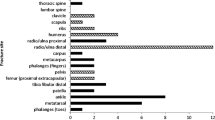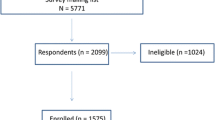Abstract
To determine the ability of bone density to predict fractures in very elderly women, we examined the association of bone density with non-spine, hip, wrist and humerus fractures in 8699 Caucasian women aged 65–79 years and 1005 women aged 80 years and older who were participants in the prospective Study of Osteoporotic Fractures. Follow-up averaged 4.9 (±1.0) years after baseline measurement of appendicular bone density (single-photon absorptiometry; Osteon-Osteo Analyzer) and 2.9 (±0.6) years after measurement of hip and anteroposterior lumbar spine bone density (dual-energy X-ray absorptiometry; Hologic QDR 1000) at a later examination. In general, measurements of bone density in the oldest women retained their predictive value for fractures. Among women aged 80 and over a 1 standard deviation decrease in bone density of the distal radius was associated with an increased risk of non-spine (relative risk: 1.6; 95% confidence interval: 1.3, 1.8), wrist (1.7; 1.2, 2.4) and humerus fracture (2.9; 1.8, 4.7), while a 1 standard deviation decrease in femoral neck bone density was associated with an increased risk of non-spine (1.9; 1.6, 2.4), humerus (2.4; 1.2, 4.7) and hip fracture (2.1; 1.4; 3.2). However, only trochanteric but not femoral neck fractures were associated with low bone density in these oldest women. The excess risk of fracture in women with below-median bone density was greater in those aged 80 years and over compared with the younger women: 38.4 v 20.4 per 1000 woman-years for non-spine fracture and 12.2 v 3.2 per 1000 woman-years for hip fracture. Densitometry remains an effective tool for identifying women who have an increased risk of fracture, even after age 80, and prevention of bone loss may be an effective approach to fracture prevention in very elderly women. Because the excess risk of fracture associated with low bone mass is highest in the very elderly, they may reap the greatest short-term benefit from efforts to prevent bone loss.
Similar content being viewed by others
References
Black D, Cummings S, Genant H, Nevitt M, Palermo L, Browner W. Axial and appendicular bone density predict fractures in older women. J Bone Miner Res 1992;7:633–8.
Cummings SR, Black DM, Nevitt MC, et al. Appendicular bone density and age predict hip fracture in women. JAMA 1990;263:665–8.
Ross P, Davis J, Vagel J, Wasnich R. A critical review of bone mass and the risk of fractures in osteoporosis. Calcif Tissue Int 1990;46:149–61.
Steiger P, Cummings SR, Black DM, Spencer NE, Genant HK. Age-related decrements in bone mineral density in women over 65. J Bone Miner Res 1992;7:625–32.
Hannan M, Felson D, Anderson J. Bone mineral desity in elderly men and women: results from the Framingham osteoporosis study. J Bone Miner Res 1992;7:547–53.
Dawson-Hughes B, Shipp C, Sadowski L, Dallal G. Bone density of the radius, spine, and hip in relation to percent of ideal body weight in postmenopausal women. Calcif Tissue Int 1987;40:310–4.
Johansson C, Mellström D, Milsom I. Reproductive factors as predictors of bone density and fractures in women at the age of 70. Maturitas 1993;17:39–50.
Gardsell P, Johnell O, Nilsson BE. Predicting fractures in women by using forearm bone densitometry. Calcif Tissue Int 1989;44:235–42.
Hui SL, Slemenda CW, Johnston CC. Baseline measurement of bone mass predicts fracture in white women. Ann Intern Med 1989;111:355–61.
Cooper C, Barker D, Morris J, Briggs R. Osteoporosis, falls and age in fracture of the proximal femur. BMJ 1987;295:13–5.
Melton L, Chrischilles E, Cooper C, Lane A, Riggs B. How many women have osteoporosis? J Bone Miner Res 1992;7:1005–10.
Cooper C, Wickham C, Walsh K. Appendicular skeletal status and hip fracture in the elderly. Bone 1991;12:361–4.
Resnick N, Greenspan SL. ‘Senile’ osteoporosis reconsidered. JAMA 1989;261:1025–9.
Hayes W, Myers E, Morris J, Gerhart T, Yett H, Lipsitz L. Impact near the hip dominates fracture risk in elderly nursing home residents who fall. Calcif Tissue Int 1993;52:192–8.
Reid IR, Evans MC, Ames R, Wattie DJ. The influence of osteophytes and aortic calcification on spinal mineral density in postmenopausal women. J Clin Endocrinol Metab 1991;72:1372–4.
Wilson C, Fogelman I, Blake GM, Rodin A. The effect of positioning on dual energy X-ray densitometry of the proximal femur. Bone Miner 1991;13:69–76.
Nevitt MC, Cummings SR, Browner WS, et al. The accuracy of self report of fractures in elderly women: evidence from a prospective study. Am J Epidemiol 1992;135:490–9.
Grisso JA, Kelsey JL, Strom BL, et al. Risk factors for falls as a cause of hip fracture in women. N Engl J Med 1991;324:1326–31.
Nevitt MC, Cummings SR, Kidd S, Black D. Risk factors for recurrent nonsyncopal falls. JAMA 1989;261:2663–8.
Nevitt MC, Cummings SR. Type of fall and risk of hip and wrist fractures: the Study of Osteoporotic Fractures. J Am Geriatr Soc 1993;41:1226–34.
Bauer D, Browner W, Cauley J, et al. Factors associated with appendicular bone mass in older women. Ann Intern Med. 1993;118:657–65.
Pocock N, Eisman J, Gwinn T, et al. Muscle strength, physical fitness, and weight but not age predict femoral neck bone mass. J Bone Miner Res 1989;4:441–8.
Rubin S, Sidney S, Black D, Browner W, Hulley S, Cummings S. High blood cholesterol in elderly men and the excess risk for coronary heart disease. Ann Intern Med. 1990;113:916–20.
Taeuber C, Rosenwaike I. A demographic portrait of America's oldest old. In: Suzman R, Willis D, Manton K, editors. The oldest old. New York: Oxford University Press, 1992:17.
Gallagher JC, Melton LJ, Riggs BL. Examination of prevalence rates of possible risk factors in a population with a fracture of the proximal femur. Clin Orthop 1980;153:158–65.
Black D, Cummings S, Melton L III. Appendicular bone mineral and a woman's lifetime risk of hip fracture. J Bone Miner Res 1992;7:639–46.
Cummings SR, Black D. Should perimenopausal women be screened for osteoporosis? Ann Intern Med 1986;104:817–23.
Johnston CC, Melton LJ, Lindsay R, Eddy DM. Clinical indications for bone mass measurements: a report from the Scientific Advisory Board of the National Osteoporosis Foundation. J Bone Miner Res 1989;4 (Suppl 2):1–28.
Chapuy M, Arlot M, Duboeuf F, et al. Vitamin D3 and calcium to prevent hip fractures in elderly women. N Engl J Med 1992;327:1637–42.
Watts NB, Harris ST, Genant HK, et al. Intermittent cyclical etidronate treatment of postmenopausal osteoporosis. N Engl J Med 1990;323:73–9.
Lindsay R, Tohme J. Estrogen treatment of patients with osteoporosis. Obstet Gynecol 1990;76:290.
Lufkin E, Wahner H, O'Fallon W, et al. Treatment of postmenopausal osteoporosis with transdermal estrogen. Ann Intern Med 1992;117:1–9.
Christiansen C, Riis B. 17 8-Estradiol and continuous norethister-one: a unique treatment for established osteoporosis in elderly women. J Clin Endocrinol Metab 1990;71:836.
Cumming RG. Calcium intake and bone mass: a quantitative review of the evidence. Calcif Tissue Int 1990;47:194–201.
Dawson-Hughes B, Dallal GE, Krall EA, Sadowski L, Sahyoun N, Tannenbaum S. A controlled trial of calcium supplementation on bone density in postmenopausal women. N Engl J Med 1990;323:878–83.
Heikinheimo R, Inkovaara J, Harju E, et al. Annual injection of vitamin D and fractures of aged bones. Calcif Tissue Int 1992;51:105–10.
Kelsy J, Browner W, Seeley D, Nevitt M, Cummings S, Group SR. Risk factors for fractures of the distal forearm and proximal humerus. Am J Epidemiol 1992;135:477–89.
Nguyen T, Sambrook P, Kelly P, Jones G, Lord S, Freund J, Eisman J. Prediction of osteoporotic fractures by postural instability and bone density. BMJ 1993;30:1111–5.
Lauritzen J, Petersen M, Lund B. Effect of external hip protectors on hip fractures. Lancet 1993;341:11–3.
Gärdsell P, Johnell O, Nilsson BE, Gullberg B. Predicting various fragility fractures in women by forearm densitometry: a follow-up study. Calcif Tissue Int 1993;52:348–53.
Seeley D, Browner W, Nevitt M, Genant H, Scott J, Cummings S. Which fractures are associated with low appendicular bone mass in elderly women? Ann Intern Med 1991;115:837–42.
Cummings SR, Black DM, Nevitt MC, Browner W, Cauley J, Ensrud K. et al. Bone density at various sites for prediction of hip fractures. Lancet 1993;341:72–5.
National Center for Health Statistics. Health statistics on older persons, United States, 1986. Hyattsville: DHHS, 1987:14. Vital and health statistics: analytical and epidemiological studies; series 3, no. 25.
Author information
Authors and Affiliations
Rights and permissions
About this article
Cite this article
Nevitt, M.C., Johnell, O., Black, D.M. et al. Bone mineral density predicts non-spine fractures in very elderly women. Osteoporosis Int 4, 325–331 (1994). https://doi.org/10.1007/BF01622192
Received:
Revised:
Issue Date:
DOI: https://doi.org/10.1007/BF01622192




